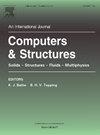On invariant and locking-free formulations for planar arbitrarily curved beams with Timoshenko-Ehrenfest beam model and peridynamic differential operator
IF 4.4
2区 工程技术
Q1 COMPUTER SCIENCE, INTERDISCIPLINARY APPLICATIONS
引用次数: 0
Abstract
This study presents three formulations for the static, dynamic, and fracture simulations of planar arbitrarily curved beams using kinematic assumptions of Timoshenko-Ehrenfest beam model and peridynamic differential operator (PDDO). Displacements of the beam axis and rotation of the cross-section are considered as unknowns of the kinematic description. Two variants of the equations of motion are derived by means of the principle of virtual work, i.e., the first form is expressed in terms of cross-sectional stress resultants, whereas the second variant is written in teams of kinematic unknowns. PDDO is then incorporated into the two variants of the equations of motion and the principle of virtual work to convert them from differential to integral expressions. The driving force behind developing three formulations is to address the critical deficiency of literature, i.e., an invariant and locking-free PD beam formulation for the analysis of beams having complex geometry is not yet proposed. In this study, the invariant property of the proposed formulations is elucidated by theoretical means, and the locking effects are examined by numerical experiments. Several well-established examples are exhibited to assess the accuracy and robustness of the proposed formulations.
求助全文
约1分钟内获得全文
求助全文
来源期刊

Computers & Structures
工程技术-工程:土木
CiteScore
8.80
自引率
6.40%
发文量
122
审稿时长
33 days
期刊介绍:
Computers & Structures publishes advances in the development and use of computational methods for the solution of problems in engineering and the sciences. The range of appropriate contributions is wide, and includes papers on establishing appropriate mathematical models and their numerical solution in all areas of mechanics. The journal also includes articles that present a substantial review of a field in the topics of the journal.
 求助内容:
求助内容: 应助结果提醒方式:
应助结果提醒方式:


